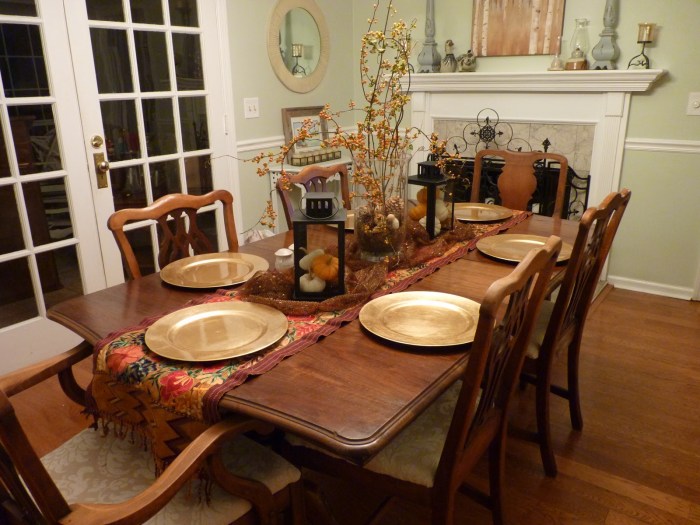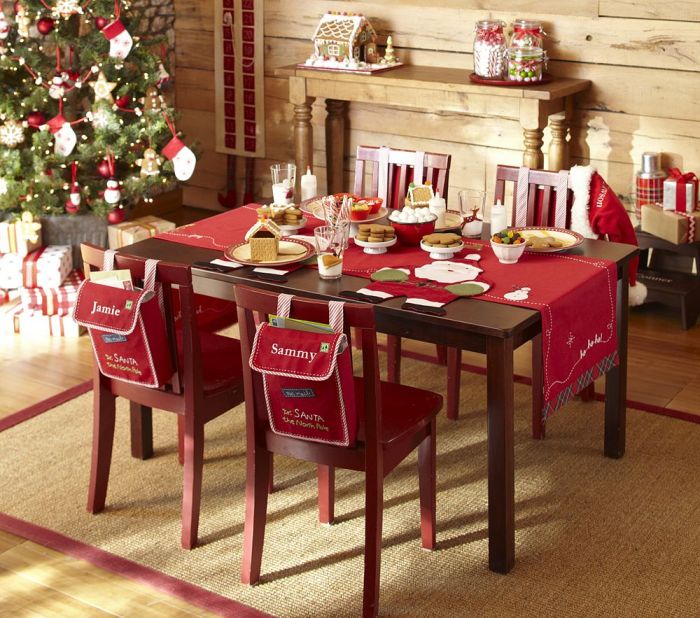Centerpiece Ideas for Dinner Tables

Decor for dinner table ideas – A dinner table, meticulously set, is a stage upon which culinary artistry and social grace intertwine. But the true star of this elegant performance? The centerpiece. It sets the mood, dictates the style, and whispers the story of the occasion. Let us delve into the captivating world of centerpiece design, exploring seasonal themes and creative flourishes that will transform your dining experience from ordinary to extraordinary.
Seasonal Centerpiece Ideas
The choice of centerpiece should resonate with the season, mirroring nature’s own artistry. A well-chosen centerpiece elevates the entire dining experience, reflecting the spirit of the moment.
Okay, so you’re totally crushing on dinner table decor ideas, right? Like, candles, chargers, the whole shebang. But don’t sleep on the vibe you can create with your coffee table decor – check out these amazing ideas for living room decor for table for some serious inspiration! That same style can totally translate to your dining room, making your dinner parties the ultimate Instagram-worthy moment.
- Spring: A vibrant arrangement of tulips, daffodils, and hyacinths in a rustic wooden crate, interspersed with sprigs of fresh rosemary and delicate ferns. The soft pastel hues and natural textures evoke the feeling of a gentle spring breeze.
- Spring: A whimsical centerpiece featuring miniature birdhouses nestled amongst blooming branches of cherry blossoms and dogwood, creating a sense of playful springtime renewal.
- Summer: A sun-drenched display of sunflowers, zinnias, and cosmos in a galvanized metal bucket, accented with bright yellow lemons and lime wedges. This bold and cheerful centerpiece captures the energy of a summer day.
- Summer: A sophisticated arrangement of hydrangeas, lavender, and roses in a clear glass vase, showcasing the elegance of summer blooms. The simple elegance complements a more formal setting.
- Autumn: A rustic centerpiece featuring gourds, pumpkins, and autumn leaves arranged on a wooden platter, with flickering candlelight casting warm, inviting shadows. The earthy tones and natural elements evoke the cozy atmosphere of autumn.
- Autumn: A dramatic centerpiece composed of branches adorned with fiery red and orange leaves, placed in a tall glass vase, creating a striking focal point that captures the vibrant hues of fall.
- Winter: A frosty centerpiece featuring pinecones, evergreen branches, and white berries arranged in a silver bowl, with shimmering white candles adding a touch of winter magic. The cool tones and natural textures create a sense of serene winter elegance.
- Winter: A minimalist centerpiece of frosted branches in a clear glass vase, accented with a few strategically placed silver ornaments. This understated centerpiece allows the beauty of the natural elements to shine through.
- Winter: A warm and inviting centerpiece featuring a collection of pillar candles in varying heights and shades of ivory and cream, creating a comforting glow on a cold winter’s night.
- Spring: A delicate arrangement of lilies of the valley and baby’s breath in a vintage silver teacup, adding a touch of romantic charm to the spring table setting.
Creative Ways to Incorporate Fresh Flowers
Fresh flowers possess an unparalleled ability to infuse life and vibrancy into any dinner table setting. Their delicate beauty and intoxicating fragrances elevate the ambiance, transforming an ordinary meal into a memorable experience.
- Floating Flowers: Submerge vibrant blooms like roses or lilies in a shallow bowl filled with water. Add floating candles for a truly ethereal effect. The delicate dance of petals and candlelight creates a magical atmosphere.
- Hanging Arrangements: Create a stunning overhead display by suspending bouquets from the ceiling or chandelier using fishing line or decorative ribbon. This unexpected approach adds a touch of drama and whimsy to the setting. The cascading blooms create a mesmerizing visual spectacle.
- Mason Jar Magic: Utilize rustic mason jars of varying sizes and heights to showcase a collection of wildflowers or garden blooms. This simple yet charming approach adds a touch of rustic elegance to the table. The charming simplicity enhances the natural beauty of the flowers.
- Floral Garland: Craft a lush garland of seasonal blooms and greenery, weaving it along the length of the table. This continuous flow of color and texture adds a touch of romance and sophistication to the setting. The flowing arrangement creates a captivating visual tapestry.
- Unexpected Vessels: Think outside the vase! Use vintage teacups, antique pitchers, or even repurposed tin cans as unique vessels to display your floral arrangements. The unexpected vessels add a touch of personality and charm. This unconventional approach showcases creativity and adds a personal touch.
Candlelit Centerpiece Designs
Candles possess a magical ability to transform a simple table setting into a captivating scene, casting a warm, inviting glow and setting the mood for an unforgettable evening.
| Design | Candle Height | Candle Color | Number of Candles |
|---|---|---|---|
| Romantic Glow | Varying heights (tall tapers and short votives) | Soft ivory and cream | 7-9 candles |
| Dramatic Statement | Tall, slender candles | Deep red or burgundy | 3-5 candles |
| Modern Minimalism | Single, medium-height pillar candle | Sleek silver or black | 1 candle |
Table Setting Essentials and Variations

The art of setting a dinner table transcends mere functionality; it’s a performance, a silent narrative woven with textiles, silverware, and glassware, reflecting the mood and intention of the gathering. A thoughtfully arranged table elevates the dining experience, transforming a simple meal into a memorable occasion. From intimate family dinners to grand formal affairs, the principles of table setting remain consistent, yet offer boundless opportunities for creativity and personalization.
The foundation of any successful table setting rests upon a few key elements, each playing a crucial role in establishing the overall aesthetic and functionality of the space. These elements work in harmony, creating a cohesive and inviting atmosphere that enhances the enjoyment of the meal.
Essential Elements of a Well-Set Dinner Table
Five essential elements contribute to a flawlessly set dinner table, each possessing its unique significance. These elements, when carefully considered and arranged, transform a simple meal into an elegant and memorable experience. The subtle interplay of these elements creates a captivating visual narrative that speaks volumes about the host’s intention and appreciation for the art of dining.
- Placemat: The placemat serves as the foundation, protecting the table surface while adding a layer of visual interest and texture. Its material and design contribute significantly to the overall aesthetic. A simple linen placemat evokes a rustic charm, while a sleek, modern design in glass or acrylic adds a touch of sophistication.
- Dinner Plate: The dinner plate is the centerpiece of the place setting, its size and design influencing the perceived formality of the occasion. A large, ornate plate suggests a formal affair, while a smaller, simpler plate creates a more casual atmosphere.
- Silverware: The arrangement of silverware reflects the formality of the event. The placement of forks, knives, and spoons follows a specific etiquette, indicating the order of courses. The weight and material of the silverware also contribute to the overall feel, with heavier, more ornate pieces suggesting formality.
- Glassware: The selection and placement of glassware are crucial. Different glasses are used for various beverages, such as water, wine, and champagne. The type of glassware used, from simple tumblers to elegant crystal, further enhances the overall aesthetic and formality of the setting.
- Napkin: The napkin is more than just a functional item; it’s a decorative element that adds a touch of elegance and sophistication. Its placement, whether casually folded or meticulously arranged, contributes to the overall style and formality of the setting. A crisp linen napkin speaks of formality, while a more casual fabric adds a relaxed feel.
Placemat Materials and Patterns
The choice of placemat significantly impacts the overall table setting style. The material and pattern of the placemat set the tone, creating a foundation upon which the rest of the setting is built. Consideration of the material and pattern allows for the expression of personal style and the creation of a cohesive and visually appealing tablescape.
- Linen: Linen placemats offer a classic, rustic elegance. Their natural texture adds warmth and sophistication to any setting. They can range from simple, plain designs to more intricate patterns, offering versatility for various styles.
- Cork: Cork placemats provide a modern, eco-friendly option. Their unique texture and neutral color palette create a versatile backdrop for various table settings. They add a touch of casual sophistication.
- Bamboo: Bamboo placemats offer a natural, sustainable alternative. Their warm tones and intricate grain patterns add a touch of organic beauty to any setting. They create a relaxed yet elegant atmosphere.
- Plastic: Plastic placemats offer a durable, easy-to-clean option, perfect for casual settings or families with children. They come in a wide array of colors and patterns, allowing for creative expression.
- Silicone: Silicone placemats provide a modern, heat-resistant option. Their sleek design and vibrant colors add a touch of contemporary flair to any table setting. They are highly durable and easy to clean.
Silverware and Glassware Arrangements: Formal and Informal Settings
The arrangement of silverware and glassware subtly communicates the level of formality of the occasion. A carefully considered placement of these elements enhances the dining experience, guiding the flow of the meal and adding a touch of elegance. The difference between formal and informal settings lies in the precision and complexity of the arrangement.
Formal Setting, Decor for dinner table ideas
- Silverware: Forks are placed to the left of the plate, with the salad fork outermost and the dinner fork closest. Knives are placed to the right of the plate, blade facing the plate. Spoons are placed to the right of the knives. Dessert silverware is placed above the plate.
- Glassware: Water glasses are placed above the knives. Wine glasses are placed to the right of the water glass, with the red wine glass outermost and the white wine glass closer to the water glass. Champagne flutes may be added if serving champagne.
Informal Setting
- Silverware: Forks are placed to the left of the plate, with the dinner fork closest. Knives are placed to the right of the plate, blade facing the plate. Spoons are placed to the right of the knives. Dessert silverware may be added if serving dessert.
- Glassware: Water glasses are placed above the knives. Wine glasses or other glasses may be added as needed.
FAQ Summary: Decor For Dinner Table Ideas
What’s the best way to choose a color palette for my dinner table?
Think about the overall vibe you’re going for! Bright and cheerful? Go for pastels. Sophisticated and elegant? Stick to neutrals. Consider the season and the occasion, too.
How do I make my table setting look more formal?
Formal settings usually include chargers, multiple forks and knives, and specific glassware placement. Pay attention to the details, and use nice linens!
What are some good alternatives to fresh flowers for a centerpiece?
Candles, branches, fruit, or even interesting rocks can make stunning centerpieces! Get creative and have fun with it.
How can I make my dinner table setting look more unique?
Add a personal touch! Incorporate family heirlooms, travel souvenirs, or handmade items to give it a one-of-a-kind look.
